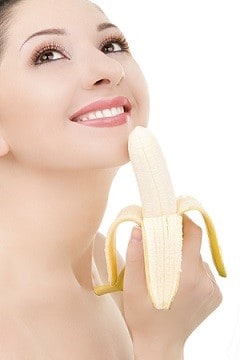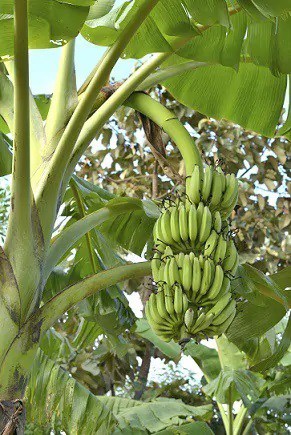 As everyone knows, the ultimate strategy for acne is squeezing them on the bathroom mirror. But there’s one equally simple contender – banana peels. It’s a favourite of beauty gurus on youtube and has even made it to national newspapers.
As everyone knows, the ultimate strategy for acne is squeezing them on the bathroom mirror. But there’s one equally simple contender – banana peels. It’s a favourite of beauty gurus on youtube and has even made it to national newspapers.
It’s a classic scenario where your head is in your hands, and dozens of bottles litter the table, when you instinctively glance up and see a gloriously fresh banana skin sitting on your window ledge, with the sunlight shining on it majestically, thus proving that it’s the solution. Some call it an old wives tale, and yes, old wives have probably used it. Old wives have recommended aloe vera before, but old wives are also fans of egg whites. The jury is out on automatically obeying everything an old wife says, but some testimonials have been fantastic: fungal infections completely gone, stubborn warts reduced to nothing after 1 week.
The strategies differ too. One is rubbing the banana peel gently into your skin for 2 hours and leaving the residue on afterwards. But I’ve even seen one guy who left the same banana peel on a wound for a whole week.
Some accuse the beauty bloggers of a generous splash of photoshop. You might also end up with an army of fruit flies following you around, which sadly, you cannot command.
Like anything, banana peel could be…
-Totally useless for acne.
-Decent for acne, but pretty pointless: inferior to grapeseed oil or aloe vera.
-A brilliant topical treatment which could finish off those last few pimples.
This, of course, falls within the context that topical treatments won’t ever cure acne, not compared to diet, but are still fantastic bonus weapons. So here’s what you need to know about banana peels…
Not just a guessing game
One lucky thing about banana peel for us acne patients is that the economics is in our favour. Fruit corporations have a problem – the skin makes up 40% of banana’s weight, yet it’s useless.
They’ve tried it for animal feed, for organic field fertiliser, for making alcohol. In Costa Rica, they just dumped the skins in a rainforest river, until it started messing up the ecosystem. So luckily, tons of studies have examined banana skins searching for useful health properties…
…and there’s one consensus: a banquet of antioxidants.
ONE: some rats took on the pleasant task of eating banana skin, for the greater good of the acneverse. Several antioxidants rose: glutathione, catalase, superoxide dismutase. Hydroperoxides fell, a biomarker of free radical activity. This was compared to rats on a normal diet. It’s not a topical study, but antioxidants tend to convert well to the face (2008 study).
TWO: scientists pretty much scooped up a random handful of fruit, and tested both the inner flesh and peels (2015 study). Banana peel didn’t win outright, but contained more antioxidants than pineapple, papaya, watermelon, passion fruit and melon peel, all of which are unexceptional (berries and pomegranate are best) yet good sources of antioxidants. Banana peel was effective against free radicals according to two different measurements: FRAP and DPPH.
THREE: examined in a laboratory, ripe banana peels had okay antioxidant powers. However, unripe ones were packed with antioxidants, particularly members of the phenolic family. The phenol count correlated well with total antioxidant activity, a sure sign (2012 study).
Right off the bat, we know that banana peel has legitimate powers. It isn’t a case of scooping up the most ordinary looking fruit item and assuming that its mundanity disguises awe-inspiring secrets. It isn’t pure, unadulterated folklore. There’s a real chance.
Over 40 phenolic compounds have been identified in the fruit. For that fact alone, we have to take the banana peel seriously.
Likewise, have you seen claims that the peel is rich in soothing anti-inflammatory goodness? Study 3 found that 4% banana skin reduced inflammation from nitric oxide more effective than indomethacin. This pharmaceutical anti-inflammatory drug is used for arthritis pain, tendonitis, and muscle stiffness.
This time, the fresh ripe peel was the most anti-inflammatory. Apparently, different ripeness equals different acne powers.
Antioxidants clear acne by deactivating free radicals, which themselves 1) create a pore-clogging compound called squalene peroxide, and 2) snatch away your skin’s glow by neutralising the antioxidants which create it. Inflammation, meanwhile, is the root cause of acne, and while diet is your top priority (getting zinc, eating omega 3s from fish) a localised topical treatment is a great bonus step, for hyper concentrated benefits.
Is gallocatechin the key?
 So we’re back with a standard verdict about a fruit. Decent antioxidants, anti-inflammatory powers – both poison to the ears of stubborn red pimples.
So we’re back with a standard verdict about a fruit. Decent antioxidants, anti-inflammatory powers – both poison to the ears of stubborn red pimples.
That’s our next question then – does banana stand out in any way? Or does it blend into an endless stream of potential topical treatments to try, never being heard from again? Crushed grapes or orange peel would work just as well.
I’m happy to tell you then, that banana peel certainly could have unique powers, and gallocatechin and leucocyanidin are why.
What on earth are those? They’re two antioxidants which banana peel is particularly rich in. Like pomegranate with its punicalagins or ginger with its gingerols, banana peel isn’t a vague mish mash of generic antioxidants; it has specialities. Gallocatechin, for example, is particularly concentrated in the peel versus the fruit; 158 mg versus 29.6mg according to this 2002 study. The gallocatechin levels actually correlated closely with the overall antioxidant power.
However, it also belongs to the famous catechin family, and unfortunately, it’s the less famous little brother. The best studied member is epigallocatechin gallate from green tea, particularly for cancer, where a mountain of cell-killing, DNA-repairing, and self-destructing powers have been unearthed – all sort of happy things (see this review). For acne, EGCG can also lower oily skin superbly, potentially by 60% in 8 weeks.
But then there’s simple gallocatechin, neglected, with almost no studies at all. This happens a lot; you have closely related antioxidant sub-families where one extra molecule can make a world of difference, with smaller members ignored; peach’s main antioxidant, procyanidin dimer B1, is a great example. There’s just so many antioxidants in nature.
This study did reduce cancer cells nicely compared to its relative epicatechin, while this one increased bone density nicely compared to its relative epigallocatechin. Nothing thrilling for acne, but the consistency between family members is promising. Why? Because if this extends to the storied EG3G, then gallocatechin could retain the fantastic powers for oily skin. They might be slightly weaker, but that would give banana peel a serious edge. Green tea is probably the strongest natural topical treatment for oily skin, so being in its shadow would be very comfortable indeed.
Gallocatechin is common in foods, but having such high amounts gives banana peel new potential. It is not just another natural plant item. That said, nothing’s proven yet.
What about leucocyanidin?
This antioxidant is most abundant in the peels of green bananas.
Levels drop during ripening, but some still survives. This time, scientists are zeroing in one acne power, and it’s wound healing.
ONE: 40 rats were divided into 4 groups, a control group, one with 2% banana peel gel applied, and two with 4% gel and 10% gel. 7 days of patience later, and the wounds contracted by 1.38-157mm in the banana peel group versus just 1.03-1.10mm in the control group. That’s a solid 30% acceleration. Beyond 4% concentrations, the benefits seemed to sputter out (study).
TWO: a nearly identical team repeated a nearly identical experiment. 120 rats were divided into controls and various banana gel concentrations, and again, their wound contraction accelerated, although differences were only noticeable by day 21. Banana peel may require patience. There was one unique result though – collagen fibres became denser.
THREE: things get real here. The scientists bought green bananas straight from a Brazilian marketstand, to mimic an ordinary person buying them. They converted the green skin to a gel and applied it to ulcers on the skin of 30 human diabetes patients. After 1 month, they concluded that “the gel made from the green banana skin per 10% has a healing action.”
These studies are fantastic for banana peel themselves, but leucocyanidin may well be responsible. Why? Because it increases the incorporation of thymidine into wounds, a component of DNA, and a biomarker scientists look for during increased cell proliferation. All of which is great for acne, and healing recently dead pimples. In fact, in marketstalls in Rio de Janeiro, new mothers are buying banana peels to heal cracked nipples from breastfeeding. It’s strongly theorised that leucocyanidin is the miracle compound. Elsewhere, we have two studies on healing stomach ulcers. Like gallocatechin, it’s a fog of scattered studies, but the potential is there – any unique compound is good news for separating from the pack. The only problem is that green banana skins may be superior for leucocyanidin, whereas gallocatechin tends to remain for longer.
Your takeaway as an acne sufferer then? Simply that banana peel has plenty for you to get excited about.
It could be an empty box of nothing, but the potential is there; all those ecstatic beauty bloggers could have experienced the gallocatechin and leucocyanidin in motion, without realising it.
NRF2 manipulation
 The most interesting banana peel study gathered 216 female chicks and fed them a control, a 0.5% banana peel diet, a 1% version and a 2% version. 4 groups then, and in the banana peel chicks, the genes for Nrf2 rose significantly in the liver.
The most interesting banana peel study gathered 216 female chicks and fed them a control, a 0.5% banana peel diet, a 1% version and a 2% version. 4 groups then, and in the banana peel chicks, the genes for Nrf2 rose significantly in the liver.
We commonly discuss NF-kappaB here, the inflammatory master molecule that stands behind all the smaller inflammatory chemicals, controlling TNF-a, IL-6 and IL-8 alike. Well, Nrf2 is like the friendly antioxidant equivalent.
Upregulating Nrf2 increases a cell’s homemade antioxidants like glutathione, superoxide dismutase (SOD) and catalase, all of which can prevent acne. Nrf2 deficiencies can even make cancer more likely, a classic free radical disease. For example, mice with the Nrf2 gene knocked out were far more vulnerable to DNA mutations from diesel fumes (study); they could cross a busy road to the cheese shop in a nice protective bubble.
As expected, the 0.5% banana peel group had greater bloodstream glutathione and SOD. The only flaw is that the study was oral, but Nrf2 does exist in the skin. It particularly defends the fragile melanin (your skin’s pigment) against free radicals, and both broccoli and the turmeric compound curcumin can increase it (study).
Could banana peel could soon join them? If so, it would be fantastic unique power. You could have a vitamin E bottle in your right hand for external antioxidants and a banana peel in your left for self-manufactured.
Alongside gallocatechin and leucocyanidin, this is banana peel’s most promising acne power.
More antioxidants
Banana peel also has 39.7mg of lutein and 7.2mg of zeaxanthin per 100 grams. We’ve hailed these carotenoid antioxidants elsewhere. They’re the signature compounds of eggs, kale and spinach, and are an elite due of antioxidants which are proven to accumulate in the skin.
Lutein also protects your eyesight as a handy bonus, although obviously, this only works as a food. Technically, you’re seeing lutein right now – it’s in your eyes. Again, this study showed “lutein predominance” in the antioxidants of banana peel, and better, it barely decreased during ripening; in “Ouro” bananas, lutein actually increased slightly from 2310.31 to 2597.93.
There was some variation among cultivars too, with Ouro having the most lutein and “marmelo” (995.10 when ripe) and “Pacovan” (1004.57) the least.
You could get lucky and buy a super-banana, or it could just be a dud. This almost certainly applies to the peel’s other antioxidants too, which apparently included beta-carotene (461.98 in ripe Ouro bananas) and alpha-carotene (248.77), the staple carotenoids which convert to vitamin A in the body. Sadly, this cannot happen when applied topically, but they’re important pigment compounds, which provide the healthy, much coveted “glow” which is actually an incredibly detailed constellation of hundreds of plant antioxidants when you zoom in really close. If your uncle happens to run the top Ouro banana farm in Brazil, then you now know what to ask for Christmas next year.
Next time you order a miracle acne pill from Amazon, open the parcel, and find only a banana skin, there’s no need to be disappointed.
The pivotal question
It’s beyond doubt now – as a raw substance, banana peel has strong acne potential.
But what about the practical side? There’s a big flaw here. The normal method is obviously to rub the banana peel over your face. It’s a ready made remedy, begging to be used; it fits into the whole theme that the banana is mother nature’s very own portable snack.
But it’s likely that lutein, gallotechin, leucoydaincin and company won’t absorb much this way. All you’re doing is rubbing outer juice into your skin. The studies trying to solve the economic conundrum of banana peels are thinking more of grinding it down into a powder, and then mixing with topical creams. Likewise, the rats took a gel made from the entire condensed banana peel.
It’s different to pouring on freshly created pomegranate juice, or orange juice, which absorb into the skin very easily (for better or worse). Topical oils like grapeseed oil or olive oil are perfect to apply. Banana peel? I highly doubt that the classic rubbing method will achieve much.
A few antioxidants will definitely make it through, but they’re mostly concentrated deeper within the yellow skin. Gallocatechin is actually an insect defence; it was found that Norwegian spruce trees produce it to ward off fungi from the bark beetle.
Therefore, they’re probably on the wrong side of the peel. We’ve done the hard work of scientific analysis, but now there’s a very basic stumbling block.
Banana peel isn’t fantastic for folk remedies either. Sure, there’s the mothers healing cracked nipples in Brazil, and there’s stories of wound healing, and insect bite calming in India. However, there’s hardly the avalanche of turmeric, aloe vera or witch hazel (a Native American favourite).
What you could do is throw a banana peel into your kitchen blender (from halfway across the room, of course), dry out the resulting goop, and mix it into homemade remedies.
Conclusion
Here’s your official verdict then. Rubbing banana peel all over your acne probably won’t reduce it, let alone cure it. That said, they’re so easily accessible that it’s worth a try.
There are no confirmed side effects and none that I can possibly imagine – neither the furocoumarins of lemon juice (sun sensitivity), nor the papain of papaya (protein disintegration).
If you’re truly dedicated, delving into the higher acne arts, then grinding down the whole peel may have unique properties due to its 3 unusually abundant compounds. It’s also confirmed to supply antioxidants and lower inflammation, the two basic acne powers. Therefore, almost any acne patient can benefit; anyone with red and angry pimples, anyone who feels like acne is controlling them rather than vice versa.
Banana peel is hardly your top focus for clearing acne – raw honey, grapeseed oil and aloe vera are much better – but its potential is great if you use it correctly.
Thanks for reading!

How long should we let it sit on our face? I wouldn’t want to show up to work with a banana all over my face.
Wouldn’t it be best to just eat the banana peel instead? It is likely packed to the brim with unique antioxidants.